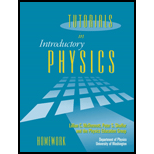
Tutorials In Introductory Physics: Homework
1st Edition
ISBN: 9780130662453
Author: Lillian C. McDermott, Peter S. Shaffer
Publisher: PEARSON
expand_more
expand_more
format_list_bulleted
Concept explainers
Textbook Question
Chapter 24.1, Problem 2bTH
Is it possible to place the bulb in another location along the horizontal dashed line so that the shadow of the triangle is twice as tall as in part a? If so, where? If not, why not?
Expert Solution & Answer
Want to see the full answer?
Check out a sample textbook solution
Students have asked these similar questions
Three slits, each separated from its neighbor by d = 0.06 mm, are illuminated by a coherent light source of
wavelength 550 nm. The slits are extremely narrow. A screen is located L = 2.5 m from the slits. The
intensity on the centerline is 0.05 W. Consider a location on the screen x = 1.72 cm from the centerline.
a) Draw the phasors, according to the phasor model for the addition of harmonic waves, appropriate for this
location.
b) From the phasor diagram, calculate the intensity of light at this location.
A Jamin interferometer is a device for measuring or for comparing the indices of refraction of gases. A beam
of monochromatic light is split into two parts, each of which is directed along the axis of a separate cylindrical
tube before being recombined into a single beam that is viewed through a telescope. Suppose we are given the
following,
•
Length of each tube is L = 0.4 m.
• λ= 598 nm.
Both tubes are initially evacuated, and constructive interference is observed in the center of the field of view. As
air is slowly let into one of the tubes, the central field of view changes dark and back to bright a total of 198
times.
(a) What is the index of refraction for air?
(b) If the fringes can be counted to ±0.25 fringe, where one fringe is equivalent to one complete cycle of
intensity variation at the center of the field of view, to what accuracy can the index of refraction of air be
determined by this experiment?
1. An arrangement of three charges is shown below where q₁ = 1.6 × 10-19 C, q2 = -1.6×10-19 C,
and q3 3.2 x 10-19 C.
2 cm
Y
93
92
91
X
3 cm
(a) Calculate the magnitude and direction of the net force on q₁.
(b) Sketch the direction of the forces on qi
Chapter 24 Solutions
Tutorials In Introductory Physics: Homework
Ch. 24.1 - On the diagram, sketch what you would see on the...Ch. 24.1 - The small bulb is replaced by three longfilament...Ch. 24.1 - The three longfilament bulbs are replaced by a...Ch. 24.1 - Predict the size and shape of the shadow that will...Ch. 24.1 - Is it possible to place the bulb in another...Ch. 24.1 - Prob. 2cTHCh. 24.1 - Prob. 2dTHCh. 24.1 - Prob. 3aTHCh. 24.1 - A student is looking at the building shown at...Ch. 24.1 - Prob. 4aTH
Ch. 24.1 - Suppose that this student were walking through the...Ch. 24.2 - The top view diagrams at right were drawn by a...Ch. 24.2 - Draw a ray diagram to determine the location of...Ch. 24.2 - Describe how you could use a ray diagram to...Ch. 24.2 - A pencil is placed in front of a plane mirror as...Ch. 24.2 - Prob. 3bTHCh. 24.3 - Prob. 1aTHCh. 24.3 - A pin is placed in front of a semicylindrical...Ch. 24.3 - Prob. 1cTHCh. 24.3 - Prob. 2aTHCh. 24.3 - A very small, very bright bulb is placed for from...Ch. 24.4 - The following are top view diagrams of solid...Ch. 24.4 - The following are top view diagrams of solid...Ch. 24.4 - The following are top view diagrams of solid...Ch. 24.4 - The following are top view diagrams of solid...Ch. 24.4 - Prob. 2THCh. 24.4 - Prob. 3aTHCh. 24.4 - Prob. 3bTHCh. 24.4 - Is the image(s) of the nail real or virtual?...Ch. 24.5 - Suppose that the bulb is placed as shown. Using...Ch. 24.5 - Prob. 1bTHCh. 24.5 - Prob. 1cTHCh. 24.5 - Prob. 1dTHCh. 24.5 - Prob. 2aTHCh. 24.5 - Treat the image produced by lens 1 as an object...Ch. 24.5 - Repeat parts a andb for the case in which lens 2...Ch. 24.6 - Reproduced below is a side view diagram of the...Ch. 24.6 - In section III of the tutorial Magnification, you...Ch. 24.6 - Two thin convex lenses and an object are arranged...Ch. 24.6 - Prob. 3bTHCh. 24.6 - Two thin convex lenses and an object are arranged...Ch. 24.6 - Prob. 3dTHCh. 24.6 - Two thin convex lenses and an object are arranged...
Additional Science Textbook Solutions
Find more solutions based on key concepts
Q1. What is the empirical formula of a compound with the molecular formula
Chemistry: A Molecular Approach (4th Edition)
Use the following graph to answer questions 3 and 4. 3. Which of the lines best depicts the log phase of a ther...
Microbiology: An Introduction
18. SCIENTIFIC THINKING By measuring the fossil remains of Homo floresiensis, scientists have estimated its wei...
Campbell Biology: Concepts & Connections (9th Edition)
All of the following processes are involved in the carbon cycle except: a. photosynthesis b. cell respiration c...
Human Biology: Concepts and Current Issues (8th Edition)
Which one of the following is not a fuel produced by microorganisms? a. algal oil b. ethanol c. hydrogen d. met...
Microbiology: An Introduction
Fill in the blanks: The nose is to the mouth. The ankle is to the knee. The ring finger is to the inde...
Human Anatomy & Physiology (2nd Edition)
Knowledge Booster
Learn more about
Need a deep-dive on the concept behind this application? Look no further. Learn more about this topic, physics and related others by exploring similar questions and additional content below.Similar questions
- (Figure 1)In each case let w be the weight of the suspended crate full of priceless art objects. The strut is uniform and also has weight w Find the direction of the force exerted on the strut by the pivot in the arrangement (a). Express your answer in degrees. Find the tension Tb in the cable in the arrangement (b). Express your answer in terms of w. Find the magnitude of the force exerted on the strut by the pivot in the arrangement (b). Express your answer in terms of w.arrow_forward(Figure 1)In each case let ww be the weight of the suspended crate full of priceless art objects. The strut is uniform and also has weight w. Find the direction of the force exerted on the strut by the pivot in the arrangement (b). Express your answer in degrees.arrow_forwardA 70.0 cm, uniform, 40.0 N shelf is supported horizontally by two vertical wires attached to the sloping ceiling (Figure 1). A very small 20.0 N tool is placed on the shelf midway between the points where the wires are attached to it. Find the tension in the left-hand wire. Express your answer with the appropriate units.arrow_forward
- Find the total bind Mev. binding energy for 13 Carbon, 6C (atomic mass = 13.0033554)arrow_forwardWhat is the 27 energy absorbed in this endothermic Auclear reaction 2] Al + 'n → 27 Mg + ! H? (The atom mass of "Al is 26.981539u. and that of 11 Mg is 26.984341u) MeVarrow_forwardWhat is the energy released in this nuclear reaction 1 F + "', H-1 O+ He? 19 19 16 (The atomic mass of 1F is 18.998403 u, and that of 20 is 15.9949154) MeV.arrow_forward
- What is the energy released in this B+ nuclear reaction خالد 2½ Al w/ Mg + ie? (The atomic mass of 11 Al is 23.9999394 and that > of 12 Mg is 23.985041 u) MeV.arrow_forwardWhat is the energy released / absorbed in this nuclear reaction 14 N+ & He → » O + ! N? (The atomic mass of 14 N is 14.003074u. 17N+ and that of 10 is 16.9991324). MeVarrow_forwardCan someone help me answer this question thanks.arrow_forward
- Can someone help me with this question thanks.arrow_forward4B. Four electrons are located on the corners of a square, one on each corner, with the sides of the square being 25 cm long. a) Draw a sketch of the scenario and use your sketch to b) Determine the total force (magnitude and direction) on one of the electrons from the other three?arrow_forwardPortfolio Problem 3. A ball is thrown vertically upwards with a speed vo from the floor of a room of height h. It hits the ceiling and then returns to the floor, from which it rebounds, managing just to hit the ceiling a second time. Assume that the coefficient of restitution between the ball and the floor, e, is equal to that between the ball and the ceiling. Compute e.arrow_forward
arrow_back_ios
SEE MORE QUESTIONS
arrow_forward_ios
Recommended textbooks for you
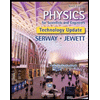 Physics for Scientists and Engineers, Technology ...PhysicsISBN:9781305116399Author:Raymond A. Serway, John W. JewettPublisher:Cengage Learning
Physics for Scientists and Engineers, Technology ...PhysicsISBN:9781305116399Author:Raymond A. Serway, John W. JewettPublisher:Cengage Learning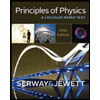 Principles of Physics: A Calculus-Based TextPhysicsISBN:9781133104261Author:Raymond A. Serway, John W. JewettPublisher:Cengage Learning
Principles of Physics: A Calculus-Based TextPhysicsISBN:9781133104261Author:Raymond A. Serway, John W. JewettPublisher:Cengage Learning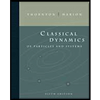 Classical Dynamics of Particles and SystemsPhysicsISBN:9780534408961Author:Stephen T. Thornton, Jerry B. MarionPublisher:Cengage Learning
Classical Dynamics of Particles and SystemsPhysicsISBN:9780534408961Author:Stephen T. Thornton, Jerry B. MarionPublisher:Cengage Learning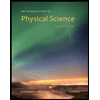 An Introduction to Physical SciencePhysicsISBN:9781305079137Author:James Shipman, Jerry D. Wilson, Charles A. Higgins, Omar TorresPublisher:Cengage Learning
An Introduction to Physical SciencePhysicsISBN:9781305079137Author:James Shipman, Jerry D. Wilson, Charles A. Higgins, Omar TorresPublisher:Cengage Learning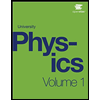 University Physics Volume 1PhysicsISBN:9781938168277Author:William Moebs, Samuel J. Ling, Jeff SannyPublisher:OpenStax - Rice University
University Physics Volume 1PhysicsISBN:9781938168277Author:William Moebs, Samuel J. Ling, Jeff SannyPublisher:OpenStax - Rice University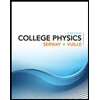 College PhysicsPhysicsISBN:9781305952300Author:Raymond A. Serway, Chris VuillePublisher:Cengage Learning
College PhysicsPhysicsISBN:9781305952300Author:Raymond A. Serway, Chris VuillePublisher:Cengage Learning

Physics for Scientists and Engineers, Technology ...
Physics
ISBN:9781305116399
Author:Raymond A. Serway, John W. Jewett
Publisher:Cengage Learning

Principles of Physics: A Calculus-Based Text
Physics
ISBN:9781133104261
Author:Raymond A. Serway, John W. Jewett
Publisher:Cengage Learning

Classical Dynamics of Particles and Systems
Physics
ISBN:9780534408961
Author:Stephen T. Thornton, Jerry B. Marion
Publisher:Cengage Learning

An Introduction to Physical Science
Physics
ISBN:9781305079137
Author:James Shipman, Jerry D. Wilson, Charles A. Higgins, Omar Torres
Publisher:Cengage Learning

University Physics Volume 1
Physics
ISBN:9781938168277
Author:William Moebs, Samuel J. Ling, Jeff Sanny
Publisher:OpenStax - Rice University

College Physics
Physics
ISBN:9781305952300
Author:Raymond A. Serway, Chris Vuille
Publisher:Cengage Learning
General Relativity: The Curvature of Spacetime; Author: Professor Dave Explains;https://www.youtube.com/watch?v=R7V3koyL7Mc;License: Standard YouTube License, CC-BY